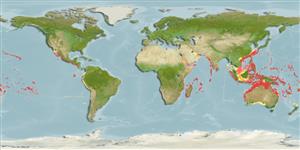Classification / Names
Common names from other countries
Main reference
Size / Weight / Age
Max length : 83.0 cm TL male/unsexed; (Ref. 40637); common length : 75.0 cm TL male/unsexed; (Ref. 5450); max. published weight: 12.0 kg (Ref. 5222)
Length at first maturity
Lm ?, range 41 - ? cm
Environment
Marine; reef-associated; non-migratory; depth range 3 - 300 m (Ref. 89972), usually 15 - ? m (Ref. 5222)
Climate / Range
Tropical, preferred 27°C (Ref. 107945); 30°N - 37°S, 30°E - 23°W (Ref. 5222)
Distribution
Indo-Pacific: Red Sea to South Africa and the Pitcairn Islands, north to southern Japan, south to New South Wales, Australia. Not found in the Persian Gulf nor in Hawaii.
Countries | FAO areas | Ecosystems | Occurrences | Introductions
Short description
Dorsal
spines
(total): 9;
Dorsal
soft rays
(total): 13-14;
Anal
spines: 3;
Anal
soft rays: 8. Juveniles conspicuous by the white line over the snout (Ref. 48635). Further characterized by yellowish brown to orange red color with numerous red, pink and lavander small spots and short dashes; pectoral, dorsal, anal and caudal fins with yellow posterior margin; front of jaws with pair of large canines; 1-2 large curved canineson side of lower jaw; elongate body, greatest depth 2.8-3.2 in SL; lunate caudal fin (Ref. 90102).
IUCN Red List Status (Ref. 115185)
Threat to humans
Reports of ciguatera poisoning (Ref. 4690)
Human uses
Fisheries: commercial; gamefish: yes; aquarium: commercial
More information
ReferencesAquacultureAquaculture profileStrainsGeneticsAllele frequenciesHeritabilityDiseasesProcessingMass conversion
Tools
Special reports
Download XML
Internet sources
Estimates of some properties based on models
Phylogenetic diversity index
PD50 = 0.7500 many relatives (e.g. carps) 0.5 - 2.0 few relatives (e.g. lungfishes)
Trophic Level
4.3 ±0.7 se; Based on diet studies.
Resilience
Medium, minimum population doubling time 1.4 - 4.4 years (K=0.18)
Vulnerability
Low to moderate vulnerability (33 of 100)
Price category
